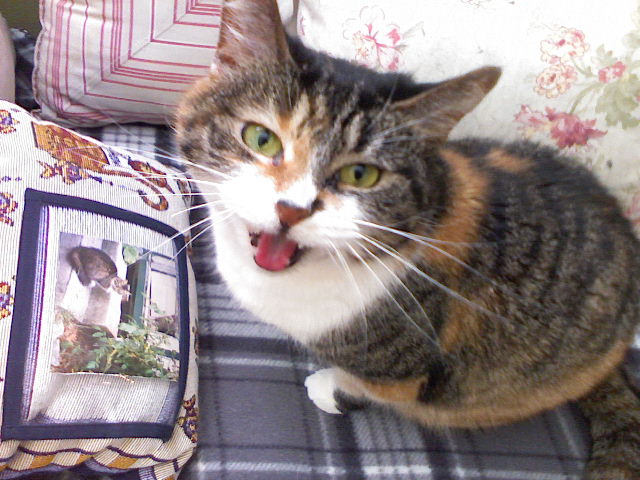Meows on:
[Wikipedia]
[Google]
[Amazon]
 A meow or miaow is a cat vocalization. ''Meows'' may have diverse tones in terms of their
A meow or miaow is a cat vocalization. ''Meows'' may have diverse tones in terms of their
 A meow or miaow is a cat vocalization. ''Meows'' may have diverse tones in terms of their
A meow or miaow is a cat vocalization. ''Meows'' may have diverse tones in terms of their sound
In physics, sound is a vibration that propagates as an acoustic wave through a transmission medium such as a gas, liquid or solid.
In human physiology and psychology, sound is the ''reception'' of such waves and their ''perception'' by the br ...
, and what is heard can vary from being chattered to calls, murmurs, and whispers. Adult cats rarely meow to each other. Thus, an adult cat meowing to human being
Humans (''Homo sapiens'') or modern humans are the most common and widespread species of primate, and the last surviving species of the genus ''Homo''. They are Hominidae, great apes characterized by their Prehistory of nakedness and clothing ...
s is generally considered a post-domestication extension of meowing by kitten
A kitten is a Juvenile (organism), juvenile cat. After being born, kittens display primary altriciality and are fully dependent on their mothers for #Establishing immunity, survival. They normally do not open their eyes for seven to ten days. A ...
s: a call for attention. Felines usually communicate with each other via their shared sense of smell
The sense of smell, or olfaction, is the special sense through which smells (or odors) are perceived. The sense of smell has many functions, including detecting desirable foods, hazards, and pheromones, and plays a role in taste.
In humans, it ...
, yet with people they often make verbal cues around behavior, such as having a specific sound indicate a desire to go outside.
A mew is a high-pitched meow often produced by kittens. It is apparently used to solicit attention from the kitten's mother, and adult cats may use it as well. The mew is similar to what is described in ''Brown et al. 1978'' as an isolation call. By around three to four weeks of age kittens do not mew when at least one littermate is present, and at four to five months of age kittens stop mewing altogether.
Background and biological details
A cat's meow can be assertive, plaintive, friendly, bold, welcoming, attention-soliciting, demanding, or complaining. It can even be silent, where the cat opens its mouth but does not vocalize. Just as humans may verbalize exhaustively when they are happy, so can cats. According to ''The Purrington Post
Images and videos of Cat, domestic cats make up some of the most viewed content on the World Wide Web. ''Thought Catalog'' has described cats as the "unofficial mascot of the Internet".
The subject attracted the attention of various scholars an ...
'', a chatty cat is likely happy too.
Meowing fundamentally evolves as a learned behavior. Formerly feral cat
A feral cat or a stray cat is an unowned domestic cat (''Felis catus'') that lives outdoors and avoids human contact; it does not allow itself to be handled or touched, and usually remains hidden from humans. Feral cats may breed over dozens ...
s meow much less often than felines accustomed to human interaction their entire lives. Particularly attached cats will meow in an imitative and reflective fashion in response to human communication
Human communication, or anthroposemiotics, is a field of study dedicated to understanding how humans Communication, communicate. Humans' ability to communicate with one another would not be possible without an understanding of what we are refere ...
that involves a back-and-forth process between the two beings, which can involve mutual emotional connection.
Etymology
InAmerican English
American English, sometimes called United States English or U.S. English, is the set of variety (linguistics), varieties of the English language native to the United States. English is the Languages of the United States, most widely spoken lang ...
, the spelling ''meow'' was first used in 1842. Before that, the word could be spelled ''miaow'', ''miau'', or ''meaw''. Of any variant, the earliest attestation of a cat's cry in Early Modern English
Early Modern English (sometimes abbreviated EModEFor example, or EMnE) or Early New English (ENE) is the stage of the English language from the beginning of the Tudor period to the English Interregnum and Restoration, or from the transit ...
is from the 1630s.
See also
*Cat communication
Cats communicate for a variety of reasons, including to show happiness, express anger, solicit attention, and observe potential prey. Additionally, they collaborate, play, and share resources. When cats communicate with humans, they do so to get ...
* Cross-linguistic onomatopoeias § Mammal sounds
* Devocalization
Devocalization (also known as ventriculocordectomy or vocal cordectomy; when performed on a dog debarking or bark softening; when performed on a cat demeowing or meow softening) is a surgical procedure where tissue is removed from the vocal cords ...
* Felinology
Felinology is the study of cats.As noted in the University of Belgrade's Faculty of Veterinary MedicinCurriculum The term is of Latin-Greek origin and comes from the Latin word ' (of cats, feline) and the Greek ' (science). Felinology is concern ...
* List of animal sounds
Certain words in the English language represent animal sounds: the noises and vocalizations of particular animals, especially noises used by animals for communication. The words can be used as verbs or interjections in addition to nouns, and ma ...
References
External links
* * * {{Authority control Animal sounds Cat behavior Onomatopoeia